| |
Discovery context:
This whistle belongs to a private collection. The owner did not know its origin.
General description:
It is a whistle set on a moneybox. The moneybox is spherical and decorated with a garland in relief. A clear brown glaze covers the higher part. The slit to introduce the coins is on the front higher part.
The whistle is located on the top of the moneybox and its connection with the moneybox is covered with a doubled clay roll. The whistle has an ovoid shape with a drawn front part. Two clay pastilles are stuck on.
The general condition is good. Three of the loops of the garland are broken.
The clay is red but covered entirely with a white slip and in the upper half with the brown glaze and at least a lead glaze. |
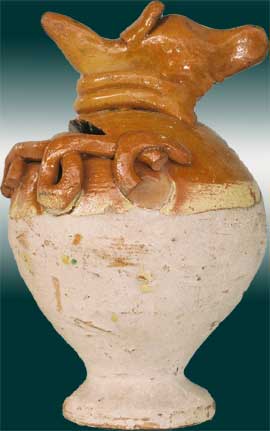
  
L max: 10,6 cm
H max: 6,9 cm
D max: 6,9 cm |
|
| |
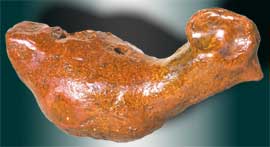
Stylized bird.
Region of Lazzio or Calabria?
H: 3.9cm; L:8.8cm; L: 3.7cm
Private Col. |
The whistle:
Although very stylized, the whistle undoubtedly represents a bird lying on its nest.
This kind of stylized bird whistle can be mostly found in Italy. It is why the research was directed immediatly towards this country. |
|
| |
For Italy, the catalogue of the exhibition of the Museo Nationale delle Arti e Tradizioni Popolari (Museum of folk arts and traditions) of Rome "La terra, il fuoco, l'acqua, il soffio" (1995) is the essential instrument of research.
This catalogue references more than 600 types of whistles classified by region. More than 300 whistles were collected in Italy between 1906 and 1910 by Lamberto Loria, founder of the museum and his collaborators. A whistle similar to the whistle of the month is refered in this old stock.
It is the whistle N°217 of the catalogue. This whistle of Tuscany was bought in 1909 per E. Miniati in Imprenuta, Firenze in Tuscany. The whistles of Tuscany are an important part of the old stock of whistles of the Roman museum.
The whistle acquired in 1909 was bought during the fair of Impruneta where they were probably manufactured. The potters of this village are known since the mid 18th century for the production of utilitarian potteries. The fair held at mid-October the first three days of the week when the Saint Lucas was celebrated. During this festival which held in front of the sanctuary of a pilgrimage to the Virgin, Loria reports that many whistles were still sold at the beginning of the 20th century.
The other whistles of the museum, bought with the whistle-moneybox, are also of good quality with a lead glaze and varied colors (red, green, brown.).
Tuscany is not the only Italian area were such moneyboxes were produced. More in the north, in Venezia, a whistle with a similar shape was manufactured in Este (Padoue) (Author: Giovani Veronese 1907). However, it is the only known whistle of this potter and this production is far from the usual Venetian production.
These whistle-moneyboxes are known in other countries. In Germany, in Mexico or in Morocco, the child is thus rewarded for puting a coin into it.
| 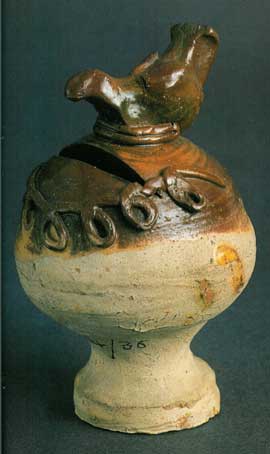
Inv. 990. National museum of Arts and Popular Traditions of Rome
(Photography of the catalogue Ed. De Luca)
H: 11.2 |
|
| |
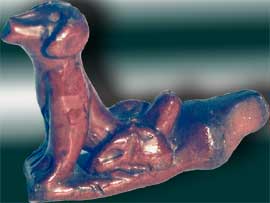
Dog
Tuscany near 1900.
Private col. |
This bird whistle is part of the general production of Tuscany. The animals are quickly made but, in spite of this stylization, their attitudes are full of life.
The types are of little varied typology: dogs, riders and water whistles in the shape of a jug with a bird posed on the top.
|
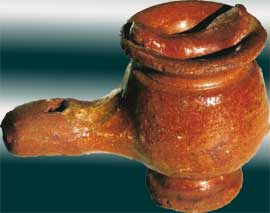
Water whistle
Seminara (?); Calabria. Mid 20th century.
Private Col.
| |